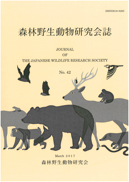Volume 29
Displaying 1-23 of 23 articles from this issue
- |<
- <
- 1
- >
- >|
-
Article type: Cover
2003 Volume 29 Pages Cover1-
Published: 2003
Released on J-STAGE: October 26, 2019
Download PDF (123K) -
Article type: Index
2003 Volume 29 Pages 1-
Published: 2003
Released on J-STAGE: October 26, 2019
Download PDF (67K) -
Article type: Article
2003 Volume 29 Pages 3-7
Published: 2003
Released on J-STAGE: October 03, 2017
Download PDF (726K) -
Article type: Article
2003 Volume 29 Pages 8-11
Published: 2003
Released on J-STAGE: October 03, 2017
Download PDF (2157K) -
Article type: Article
2003 Volume 29 Pages 12-18
Published: 2003
Released on J-STAGE: October 03, 2017
Download PDF (5887K) -
Article type: Article
2003 Volume 29 Pages 19-24
Published: 2003
Released on J-STAGE: October 03, 2017
Download PDF (2115K) -
Article type: Article
2003 Volume 29 Pages 25-36
Published: 2003
Released on J-STAGE: October 03, 2017
Download PDF (1481K) -
Article type: Article
2003 Volume 29 Pages 37-38
Published: 2003
Released on J-STAGE: October 03, 2017
Download PDF (400K) -
Article type: Article
2003 Volume 29 Pages 39-52
Published: 2003
Released on J-STAGE: October 03, 2017
Download PDF (2712K) -
Article type: Article
2003 Volume 29 Pages 53-57
Published: 2003
Released on J-STAGE: October 03, 2017
Download PDF (1754K) -
Article type: Article
2003 Volume 29 Pages 58-60
Published: 2003
Released on J-STAGE: October 03, 2017
Download PDF (906K) -
Article type: Article
2003 Volume 29 Pages 61-62
Published: 2003
Released on J-STAGE: October 03, 2017
Download PDF (554K) -
Article type: Appendix
2003 Volume 29 Pages 63-64
Published: 2003
Released on J-STAGE: October 03, 2017
Download PDF (200K) -
Article type: Appendix
2003 Volume 29 Pages 65-
Published: 2003
Released on J-STAGE: October 26, 2019
Download PDF (122K) -
Article type: Appendix
2003 Volume 29 Pages 66-
Published: 2003
Released on J-STAGE: October 26, 2019
Download PDF (94K) -
Article type: Appendix
2003 Volume 29 Pages 67-70
Published: 2003
Released on J-STAGE: October 26, 2019
Download PDF (315K) -
Article type: Appendix
2003 Volume 29 Pages 71-
Published: 2003
Released on J-STAGE: October 26, 2019
Download PDF (72K) -
Article type: Appendix
2003 Volume 29 Pages 71-
Published: 2003
Released on J-STAGE: October 26, 2019
Download PDF (72K) -
Article type: Appendix
2003 Volume 29 Pages 72-
Published: 2003
Released on J-STAGE: October 26, 2019
Download PDF (63K) -
Article type: Appendix
2003 Volume 29 Pages App1-
Published: 2003
Released on J-STAGE: October 26, 2019
Download PDF (33K) -
Article type: Appendix
2003 Volume 29 Pages App2-
Published: 2003
Released on J-STAGE: October 26, 2019
Download PDF (33K) -
Article type: Cover
2003 Volume 29 Pages Cover2-
Published: 2003
Released on J-STAGE: October 26, 2019
Download PDF (61K) -
Article type: Index
2003 Volume 29 Pages Toc1-
Published: 2003
Released on J-STAGE: October 26, 2019
Download PDF (61K)
- |<
- <
- 1
- >
- >|
